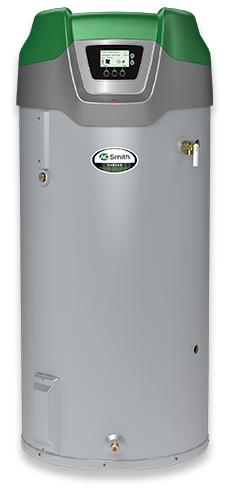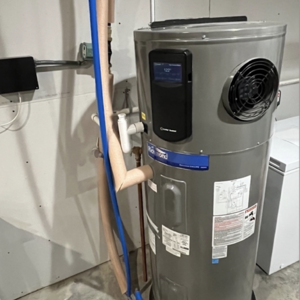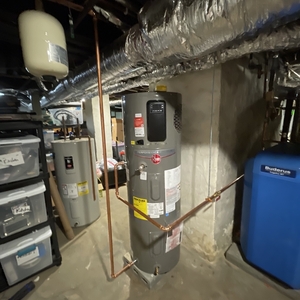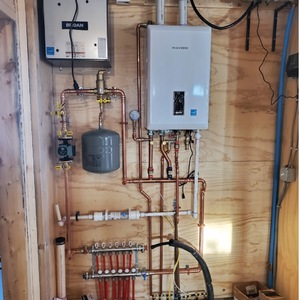
Image Credit: A.O. Smith
Vladimir Polyakov’s two-story colonial is undergoing a down-to-the-studs rehab, with insulation upgrades and a new heating system on the way.
“I am trying to put together a system that can deliver domestic hot water and heat the house,” he writes in a Q&A post at Green Building Advisor. “The colonial house is in Brooklyn, New York, 29 feet by 33 feet, and consists of two floors plus basement. I am doing a complete renovation. I already removed all walls throughout the house and will use closed-cell foam insulation in all walls and roof. I plan to run PEX in joists for both floors and I am thinking of using baseboard in the basement.”
That’s the rough outline of his plan, but Polyakov is concerned about oversizing the boiler. He’s come across several companies online that design and prefabricate systems that produce both domestic hot water and hot water for heat.
One of the systems uses a Takagi on-demand hot water heater. “Will this water heater short-cycle in my scenario?” Polyakov asks. “Is it better to use a dedicated boiler instead?”
His quest for an efficient combi-system is the topic for this Q&A Spotlight.
Some cautions about designing the system
System design is complicated, and the idea that Polyakov is taking on this challenge makes GBA senior editor Martin Holladay a little nervous.
“This is a big topic,” he writes. “The nature of your questions makes me wonder whether you will be able to design your own hydronic heating system. I suggest that you consult with a mechanical engineer or a reputable HVAC contractor with experience designing hydronic systems, because you probably don’t want to learn everything about this topic, starting from scratch.”
GBA has published a number of articles in this general topic (see…
Weekly Newsletter
Get building science and energy efficiency advice, plus special offers, in your inbox.

This article is only available to GBA Prime Members
Sign up for a free trial and get instant access to this article as well as GBA’s complete library of premium articles and construction details.
Start Free TrialAlready a member? Log in















8 Comments
Most fan-fold XPS is Class II , not Class-I @ Peter Yost
"When XPS is 1/2 in. or thinner (as any fan-fold XPS is), they laminate a polypropylene skin on each side to make it stronger, rendering the insulation a Class I vapor retarder/"
Rarely (if ever) are they Class I. The thin polyolefin skins on fan-fold are typically in the 0.6-.1.5 perm range, with a few exceptions that are both higher and lower. Manyr are in the Class III range, only unperforated aluminum clad fan fold reached Class-I performance. When it matters it's important to read the specifcations, but with inherently back-ventilated vinyl siding it's fine in zone 4A to simply let it dry toward the exterior.
For instance, Pactiv's thin-XPS board products are specified at 0.8 perms, the vapor-open end of Class-II vapor retardency:
https://www.trustgreenguard.com/insulation-board/xps-insulation-board/
But their fan-fold siding underlayments are between 1.3-1.7 perms, Class III vapor retardency:
https://www.trustgreenguard.com/xps-siding-underlayment/xp-series-fanfold-underlayment/
https://www.trustgreenguard.com/xps-siding-underlayment/p-series-fanfold-underlayment/
https://www.trustgreenguard.com/xps-siding-underlayment/q-series-fanfold-underlayment/
The reason manufacturers make fan-fold siding underlayments more vapor open is precisely to allow more drying because it's on the exterior and fairly low-R, not enough to provide IRC prescriptives for dew point control from zones 4-8
Siegenthaler on Hydronic Heating in Low-Load Homes
Echoing other contributors--a low-mass boiler combined with a low-load home hydronic system has lots of potential problems. If anyone wanted to delve into more detail, John Siegenthaler did a nice writeup in JLC on this topic:
Hydronic Heating for Low-Load Houses
With the right hardware and layout, hot-water heating saves energy and makes ideal use of the sun
http://www.jlconline.com/how-to/hvac/hydronic-heating-for-low-load-houses_o
One particular problem is if you add zoning to your low load home--your emitter/heat shedding equipment becomes even smaller than a low-load home's equipment. A key pull quotes:
Of course, per the discussion above--a hydronic system is lovely and elegant, but provides no option for cooling, and is likely to be more complex and expensive than a MSHP system.
these boilers can still
Another solution is to put bypass valves on most of the zone valves. Then the zone valves are a high/low selector instead of on/off. The result is much more minimum output. And less noise.
Navies NCB-180, Fan
I've been involved in a couple of projects that used a Navien NCB-180. They are heating well insulated slabs and that side of the system seems to be fine. My question is that there is no clear data on the DHW efficiency of these units. An internal flat plate exchanger is used to heat the DHW, and basically I had to use the efficiency of the boiler and the approximate efficiency of a flat plate exchanger to come up with a number. Anybody know if there's real DHW numbers out there on these, if not, why they're not required to provide them. Also, general feelings on these unit and the set up are welcome. So far they seem to be working fine.
Also, please do not mention the existence of fan-fold let alone its use. It serves only as excuse for contractors to do poor quality work on the exterior of homes. There is no useful application of this product that can make up the disservice it does the industry. In it's typical application it has almost no r-value, does not provide an air barrier, or a barrier to liquid water. I'm sure somebody is installing it correctly but I haven't seen it. For an interior application how about a 1/2" of EPS, better blowing agents as well. Obviously this is my opinion and up for debate.
Fan-fold was comparison, not a recommendation. @ Andy Kosick
""Why closed-cell foam?" he asks. "It has twice the polymer per R as half-pound open-cell foam, and uses much more damaging HFC blowing agents (instead of water), and adds very little to the ‘whole wall’ performance when used as cavity fill in a wood-framed structure, less than R-2. For less money you could do the cavity fill as open-cell foam, and buy back the whole-wall R with fan-fold XPS siding underlayment on the interior side, behind the wallboard."
The point is to directly compare just how LITTLE is gained un studwalls by using R6/inch closed cell foam insulation compared to R3.7/inch insulation, and the extremely poor R/$. The gain in performance with closed cell foam cavity fill vs. open cell foam is comparable to what is gained by 3/8" of continuous layer of XPS, which is very small, yet comes with a HUGE cash upcharge,and dramatically larger environmental footprint.
At the bottom line: Save the higher-impact high R/inch stuff for where it is not thermally bridged by framing so that the full thermal performance can be realized.
response to D Dorsett
Apologies, I obviously misread the intent of the statement. Forgive me, fan-fold is an acute pet peeve of mine.
Rinnai Q Premier
THE RINNAI Q PREMIER might be what your looking for hot water and heat
Too much min-fire output, not enough buffer @ Scott Goodman
There's only 24 gallons of domestic hot water in the Rinnai QP130, and only 1.4 gallons in the HX. This might be enough for a showering-only single bath unit in NYC, but could be tough to fill a soaking tub. We'd need to know a lot more about the domestic hot water loads. The min-fire output is probably higher than his design heat load too.
The QP85 would be even sketchier on the domestic hot water delivery end same 24 gallons, but only 85K of burner, and still more than half his likely design heat load at low-fire.
https://assets.nationalbuildersupply.com/ul_pdfs/rinnai-qp130n-spec-sheet.pdf
https://assets.nationalbuildersupply.com/ul_pdfs/rinnai-qp85n-spec-sheet.pdf
Like most combi-boilers, it's tough to find a good fit.
Log in or become a member to post a comment.
Sign up Log in